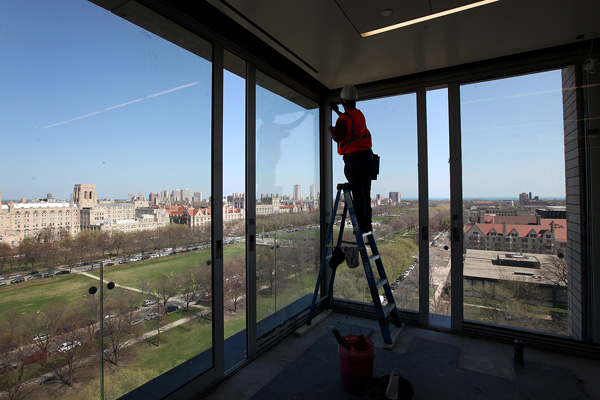
Photo: Heather Charles/Chicago Tribune
A worker does some maintenance on the Logan Center at the University of Chicago.
If you can look past the classically disdainful New York Times-style hed, "Once Just a Punch Line, Buffalo Fights Back," this is a good update on the eastern terminus of the Rust Belt and its plans to drive the economy in the 21st century. Which are not surprising, but seem to be working:
In 2006, the campus’s first new building—the $24 million Hauptman-Woodward Research Institute for structural biology—was finished, with 73,000 square feet. Last year, three more projects were completed: a $291 million research and clinical care building that houses the Gates Vascular Institute and the State University of New York at Buffalo’s Clinical and Translational Research Center (475,000 square feet in 10 stories); the $64 million 300-bed HighPointe on Michigan skilled nursing center (202,000 square feet); and a $37 million, 2,000-space parking deck.
The Medical Campus now employs 12,000 people, with possibly thousands more once another phase of development is finished about four years from now.
12,000 is a lot of people—by comparison, the Illinois Medical District in Chicago employs 20,000. In a smaller city, it makes a bigger impact: Chicago's unemployment rate is 10.3 percent; Buffalo's, 9.6 percent.
Bankrupt Detroit is now at 16 percent. When I read the story about Buffalo, I thought of something Edward McClelland wrote in his piece on the eternal question, why Chicago isn't Detroit (for what it's worth, Buffalo, Cleveland, and Pittsburgh aren't, either):
Chicago always had a more diversified economy than its Midwestern rivals. Besides forging steel and slaughtering cattle, Chicago published books, wrote insurance, traded grain futures, and issued bank loans. As the headquarters of the Mercantile Exchange and the Board of Trade, it was the Midwest’s financial hub. Chiefly because of the University of Chicago, it was home to more Nobel laureates than any other city in the world.
While my diploma increases a bit in value every time someone writes something like that, the many many thousands of non-Nobel-laureates the University of Chicago has employed over the years are also important to the city's economic base. And the folks at Northwestern, Loyola, DePaul, and UIC, which combined employ in the ballpark of 40,000-50,000 people, not to mention the smaller two- and four-year institutions housed in the city.
In Philadelphia, the University of Pennsylvania and its health system are two of the top employers. Ditto for Pittsburgh, where the Pitt health system is number one and the university is number four. Cleveland's largest employer is the Cleveland Clinic, with 34,000 employees.
Detroit's top higher ed employer is Wayne State, which employed about 5,000 people as of 2008. Adding the Detroit Medical Center, affiliated with Wayne State and Michigan State, is another 12,000. That's still far from the higher-ed and affiliated employment of its Midwestern and Rust Belt peers.
Why? Justin Pope had an interesting piece about this in The Atlantic Cities. The answer is that no one really knows, but Pope has a couple intriguing theories, both of which have to do with the city's industrial monoculture:
Perhaps it was just Detroit's bad luck that Ford, its most famous industrialist, hated cities (he once said the only solution to the city "problem" was for people to leave them). He also hated elites. And Jews. Together those traits didn't add up to someone likely to spend his money on a large urban university (though Ford did take over and support Detroit's city hospital).
But Ford didn't run Detroit, and the men who followed him were't raging antisemites. They were, however, provincial in their own way:
Detroit's business culture, Fishman told me, contained a deep suspicion of academia. He noted each of the Big Three ran their own tech schools and enormous in-house research operations, and all were distrustful of outsiders, preferring to promote from within.
Universities don't just indirectly contribute to a city's economy by dumping classes of smart young people into the local economy every year; they also employ a lot of people, many with good incomes, considerable stability, and essentially immobile jobs (we'll see about MOOCs). And they last a long time—the city's big private universities all predate the city's big private employers. For all the low problems Detroit has suffered, a vacuum in its higher education economy is a crucial one.


